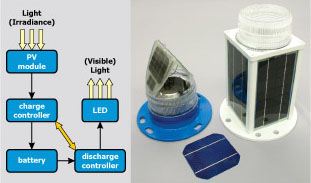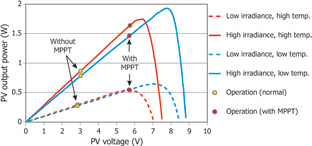|

Standalone PV-LED Lighting for Aviation

(left) Operation flowchart of a PV lighting system. (right) Examples of PV-powered LED signal lighting for aviation applications. An unmounted PV module is shown in the center.

The addition of a maximum power point tracking (MPPT) controller significantly increases PV module output power. |
Solar (PV)-powered LED lighting is gaining a foothold in aviation because of the energy-saving potential of both photovoltaic power and LED systems. In particular, PV-powered lighting systems are ideal for rural and remote airfields without access to the electrical grid.
The LRC conducted a study to understand the factors that affect the performance of standalone PV-LED lighting systems, especially how the charge controller affects total system performance.
BACKGROUND
The charge controller’s main function is to convert power from the PV module to battery power, where it can be stored for use by the discharge controller to power the LEDs. The discharge controller maintains a fixed current while the voltage is changing. Temperature and solar irradiance influence PV cell performance. For a given solar radiation intensity and PV cell temperature, there exists a maximum power point. Systems with maximum power point tracking (MPPT) can force the operating point toward an optimal condition by changing the internal impedance. Therefore, MPPT may improve the charging efficiency of the battery.
EXPERIMENT AND RESULTS
LRC researchers set up a temperature-controlled experiment to understand how the charge controller circuit affects power output from a PV module in a standalone system. Different temperatures, irradiances, current and voltage were applied to the test system, as well as the use of an MPPT controller.
In general, high irradiance, low temperature, and an MPPT controller will provide the fastest charging rate. The experiment results showed:
- Higher irradiance = Higher output power and a faster charging rate
- Higher temperature = Lower output power and a slower charging rate
- With an MPPT controller, the PV output power increases and enhances the charging rate.
MPPT controllers are cost-effective and easy to manufacture, yet not all standalone PV systems have them.
PUBLICATIONS
Project Summary Sheet 
SPONSOR
Federal Aviation Administration
|


